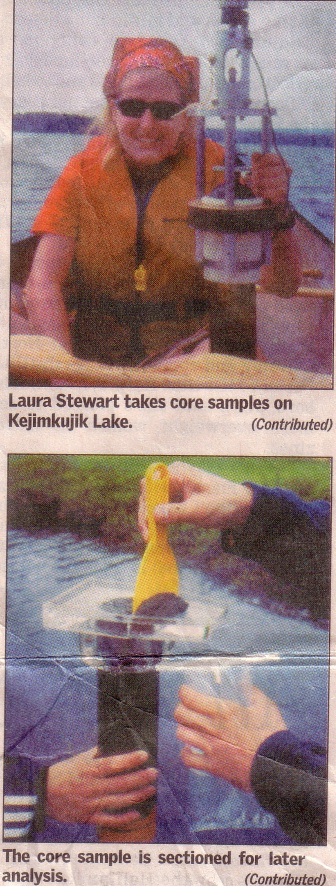Disclaimer & Copyright Notices; Optimized for the MS Internet Explorer

Although the process of recovery has begun, it could be up to a century before the province's lakes return to the state they were in before acidification.
Nova Scotia lakes were widely damaged after vast amounts of sulphur dioxide were pumped into the atmosphere by fossil fuel-burning industries between the 1930s and 1990s. The damage was greatest in the south of the province, between Halifax and Yarmouth, because these lakes were most affected by air currents that brought pollution from Ontario and the U.S.
 "It
can be horrifying to see the effect that burning coal in Boston in the
1930s had on the lakes of Nova Scotia," says Brian Ginn, a PhD student
involved in a lake study being done by Ontario's Trent and Queen's universities.
"It
can be horrifying to see the effect that burning coal in Boston in the
1930s had on the lakes of Nova Scotia," says Brian Ginn, a PhD student
involved in a lake study being done by Ontario's Trent and Queen's universities.
In the 1990s, limits were imposed on sulphur dioxide emissions. Lakes in some parts of North America, as in the northeastern U.S. and Ontario, have already responded to the reduced levels and are returning to their original condition.
But in Nova Scotia, environmental factors are slowing recovery - for example, Nova Scotian bedrocks like granite and slate provided no protective buffering capacity and allowed the acid to do its worst. (Limestone bedrock, on the other hand, raises a lake's pH level and helps protect it.)
Unfortunately, one of the province's most beautiful natural areas was hard hit - lakes in Kejimkujik National Park have been "hammered", according to Ginn.
"Hikers or canoeists at Kejimkujik, won't see many of the direct effects," he says.
"But there are indirect effects. Acid rain mobilizes metals, such as aluminum, mercury and cadmium from soils and washes them into lakes where they change which species of algae can survive. These changes then ripple up the food chain."
"Mercury has impacted loon populations and their ability to reproduce as well as fish populations - because they're a food source for the loons. One of the main draws of Kejimkujik's wilderness is its unspoiled beauty, and I doubt anyone would have a complete experience without hearing the loons calling to each other."
Lakes around Bridgewater were also badly hit. Pockwock Lake, which supplies drinking water to Halifax, used to be tea-coloured and rich in life but is now bleached and much less productive. Haligonians don't need to worry about water acidity as the Regional Water Commission adjusts the pH of drinking water; but it's a sign that damage has been extreme. Lakes in Cape Breton were less affected because they are farther away from pollution-carrying airstreams.
The researchers have been able to examine the damage caused by acid rain by fine-tuning a technique called paleolimnology. The method involves taking a vertical core sample through layers of lake sediments. Under the microscope, researchers can identify the life forms that existed within and around the lake in the past and so infer the environmental conditions that allowed the plants and animals to thrive.
The technique can be used to examine the environment as far back as the last ice age, 10,000 to 14,000 years ago, when most of the province's lakes were formed, and researchers claim it's very accurate.
The changes caused by acid rain are plainly written in the muddy archives of lake history, according to Ginn..
"We saw that algae that had been stable for 300 years, almost disappeared within one year during the 1930s," he said.
"Changes like this impact on the food chain because algae are eaten by small animals that are eaten by fish. Throughout Nova Scotia, there's been a widespread decline in populations of wild brook trout - acid rain affects their gills - and Atlantic salmon were decimated when rivers and lakes became acidic."
"Brook trout are a little more tolerant to pH changes than salmon and will recover sooner. But populations of Atlantic salmon have been wiped out in many of the historic angling rivers, especially along the South Shore between Yarmouth and Bridgewater, and there are greatly reduced populations in most of the others. Acid rain, combined with intensive angling, lowered salmon numbers to the point where now, even with an angling ban, there's been no recovery due to failures in reproduction due to low pH."
The research project that Ginn is involved in, Trends in Eutrophication and Acidification in the Maritime Provinces, is now in the third year of a five-year study of issues affecting water quality in Nova Scotia and southern New Brunswick.
The project will next look at lakes around Halifax to assess how the expansion of urban areas is affecting them. Global warming is also being examined: A team affiliated with the lake study is using the same coring technique in the arctic to assess climate change.
"It's a clear-cut open-and-shut case that acidification of the environment happened," says Ginn. "Global warming is also happening. Over the last 150 years, we've completely altered the global temperature. Researchers in the Arctic report that Arctic ponds that used to contain water year-round are now drying up during summer."